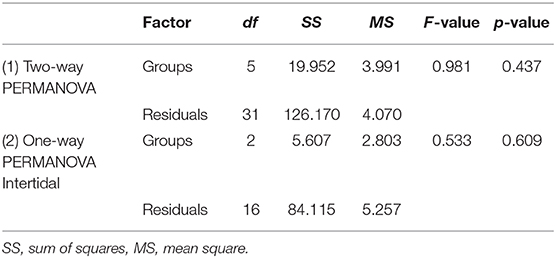- 1Department of Freshwater and Marine Ecology, Institute for Biodiversity and Ecosystem Dynamics, University of Amsterdam, Amsterdam, Netherlands
- 2Oceans Graduate School and ARC Centre of Excellence for Coral Reef Studies, The University of Western Australia, Perth, WA, Australia
- 3The UWA Oceans Institute, Indian Ocean Marine Research Centre, The University of Western Australia, Perth, WA, Australia
- 4Department of Biology and Chemistry, University of Bremen, Bremen, Germany
- 5Trace and Environmental DNA (TrEnD) Laboratory, School of Molecular and Life Sciences, Curtin University, Perth, WA, Australia
- 6School of Environmental and Life Sciences, University of Newcastle, Callaghan, NSW, Australia
- 7Australian Institute of Marine Science, Indian Ocean Marine Research Centre, Perth, WA, Australia
A Corrigendum on
Thermally Variable, Macrotidal Reef Habitats Promote Rapid Recovery From Mass Coral Bleaching
by Schoepf, V., Jung, M. U., McCulloch, M. T., White, N. E., Stat, M., and Thomas, L. (2020). Front. Mar. Sci. 7:245. doi: 10.3389/fmars.2020.00245
In the original article, there was an error. In the Materials and Methods section, subsection Statistical Analyses, Coral Health Surveys, it was incorrectly stated that the study design for the PERMANOVAs used to analyze coral health and community composition was a balanced design. Six replicate transects were used for all environments and time points, except in the intertidal in January 2016 where n = 7 transects were conducted (Le Nohaïc et al., 2017). In order to ensure that this imbalance did not affect assumptions underlying a PERMANOVA (Anderson and Walsh, 2013), we conducted a permutation test for homogeneity of multivariate dispersions using the betadisper function of the vegan package in R (Oksanen et al., 2016) with 999 permutations. The tests revealed that the assumption of homogeneity of multivariate dispersions was indeed fulfilled for both PERMANOVAs that involved the “intertidal January 2016” group (Table 1).

Table 1. Results from tests for homogeneity of multivariate dispersions for PERMANOVAs assessing (1) the effect of environment and time on coral health across all surveyed coral genera and (2) the effect of time on coral health across all surveyed coral genera in the intertidal only.
A correction has been made to Material and Methods, Statistical Analyses, Coral Health Surveys, the first paragraph:
Coral health and community composition was analyzed using permutational multivariate analysis of variance (PERMANOVAs). Prior to multivariate statistical analysis, count data were converted to percent abundance and square root transformed. The four health categories (UB, M, S, and D) across all coral genera were statistically tested for differences between environments (intertidal, subtidal) and time points (January, April, and October 2016) using two-way PERMANOVAs, the Bray–Curtis similarity index, and 9999 permutations. Transects served as replicates. Six replicate transects were used for all environments and time points, except in the intertidal in January 2016 where n = 7 transects were conducted (Le Nohaïc et al., 2017). Since PERMANOVA is largely unaffected by heterogeneity of multivariate dispersions and differences in correlation structure in balanced designs (Anderson and Walsh, 2013), we did not specifically test for this when the design was balanced (i.e., all analyses not involving the intertidal January 2016 time point). For analyses involving the intertidal January 2016 time point, we conducted a permutation test for homogeneity of multivariate dispersions using the betadisper function of the vegan package in R (Oksanen et al., 2016) with 999 permutations. The tests revealed that the assumption of homogeneity of multivariate dispersions was indeed fulfilled for both PERMANOVAs that involved the “intertidal January 2016” group (Table 1).
Additional one-way PERMANOVAs were conducted to (1) to test for the effect of time on coral health across all genera in the intertidal and subtidal, respectively and (2) to compare intertidal and subtidal at the recovery time point (October). Post hoc pairwise comparisons were calculated, with p values adjusted using the sequential Bonferroni correction. Principal component analysis was used to visualize the data. The software PAST was used for the PERMANOVA and PCA analyses (Hammer and Ryan, 2001).
The authors apologize for this error and state that this does not change the scientific conclusions of the article in any way. The original article has been updated.
References
Anderson, M. J., and Walsh, D. C. I. (2013). PERMANOVA, ANOSIM, and the mantel test in the face of heterogeneous dispersions: what null hypothesis are you testing? Ecol. Monogr. 83, 557–574. doi: 10.1890/12-2010.1
Hammer, Ø, Harper, D. A. T., and Ryan, P. D. (2001). Paleontological statistics software package for education and data analysis. Palaeontol. Electron. 41:1.
Le Nohaïc, M., Ross, C. L., Cornwall, C. E., Comeau, S., Lowe, R., McCulloch, M. T., et al. (2017). Marine heatwave causes unprecedented regional mass bleaching of thermally resistant corals in northwestern Australia. Sci. Rep. 7, 1–11. doi: 10.1038/s41598-017-14794-y
Keywords: coral bleaching, recovery capacity, temperature variability, Kimberley region, Acropora aspera, cryptic species
Citation: Schoepf V, Jung MU, McCulloch MT, White NE, Stat M and Thomas L (2020) Corrigendum: Thermally Variable, Macrotidal Reef Habitats Promote Rapid Recovery From Mass Coral Bleaching. Front. Mar. Sci. 7:702. doi: 10.3389/fmars.2020.00702
Received: 29 July 2020; Accepted: 31 July 2020;
Published: 04 September 2020.
Edited and reviewed by: Peng Jin, University of Guangzhou, China
Copyright © 2020 Schoepf, Jung, McCulloch, White, Stat and Thomas. This is an open-access article distributed under the terms of the Creative Commons Attribution License (CC BY). The use, distribution or reproduction in other forums is permitted, provided the original author(s) and the copyright owner(s) are credited and that the original publication in this journal is cited, in accordance with accepted academic practice. No use, distribution or reproduction is permitted which does not comply with these terms.
*Correspondence: Verena Schoepf, di5zY2hvZXBmQHV2YS5ubA==
†These authors have contributed equally to this work
 Verena Schoepf
Verena Schoepf Maria U. Jung
Maria U. Jung Malcolm T. McCulloch
Malcolm T. McCulloch Nicole E. White5
Nicole E. White5 Luke Thomas
Luke Thomas